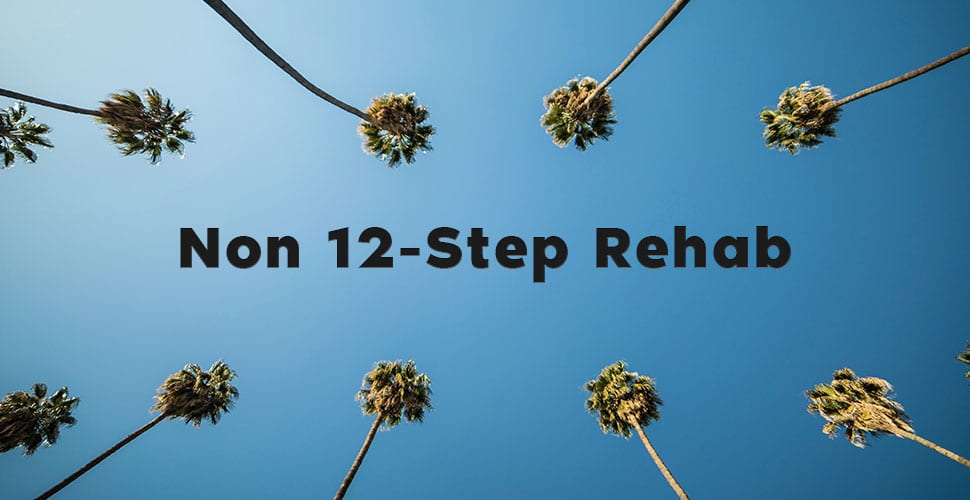Non 12 Step Rehab Los Angeles
Non 12 Step Rehab Approach
There are many choices when thinking about addiction treatment and in some cases non 12 step rehab and aa alternatives are a better choice. I think you’ll agree with us when we say times have changed and not all addiction cases should be treated the same way.
Traditional 12 Step Programs are based on a relationship with a higher power, an external higher power. According to the National Institute on Drug Abuse (NIH), “Medications should be combined with behavioral counseling for a “whole patient” approach, known as Medication Assisted Treatment (MAT).” and is an effective treatment for addiction.
Personality, personal values, history, underlying conditions and other factors dictate what type of recovery program works best for an individual. We empower clients to invest in their own recovery which aids each individual in taking responsibility for their behaviors and breeds self-reliance.
How Non 12 Step Rehab and AA Alternatives Can Help You
Addiction is an incredibly complex and far-reaching disease that we have only recently been able to even partially understand.
Its roots dig deep into a variety of modalities of the self. An addict is consumed by their drive to use and abuse a substance – so much so that their intellect, emotions, behaviors, motivations, and even their core personality are all altered by this drive.
As a result, it can be difficult to determine where the “person” ends and the “addiction” begins.
The degree of separation between these two aspects has long been up for debate in the addiction community. The traditional model of addiction (which 12 step programs like AA and NA are built from) hinged on the assumption that addiction was a result of a broken personality – a flawed morality that permeated someone’s entire being.
However, a new understanding of addiction is emerging which looks at substance use disorders not as a personal failing but rather as a disease. Facilities that run off of this assumption are much more likely to practice evidence-based treatments like therapy and medication-assisted treatment (MAT) plans, the combination of which has been proven far more effective than the traditional 12 step rehabs.
Revive Detox can recommend a variety of MATs to help our patients get through the painful withdrawals associated with detoxification. What’s more, Revive also offers a number of additional services including nutritional therapy, emotional and psychological support, and holistic services to help your body recover during detox and ensure you’re better equipped for sobriety than ever.
That’s why Revive is unquestionably one of the best NA and AA alternatives in the Los Angeles area.
- AA Alternatives and Non 12 Step Rehab
Revive’s West Los Angeles facility continuously sets new standards in detox and treatment services for drug & alcohol addiction - Expertise in Addiction Care and Guidance
Utilizing the absolute finest in addiction therapies and holistic services – combining luxury with superior staff and depth in care - Top Level Staff & Client Success
At Revive, your daily clinical support team consists of RN’s and EMT’s whereas most drug rehab centers simply utilize techs. - Experience Addiction Recovery on a Whole New Level
Led by a nationally acclaimed team of physicians and detox & addiction treatment professionals, along with a phenomenal professional support team.
The Old Model of Addiction Treatment
For centuries, addiction has been treated as a kind of personal failure. For many, an inability to overcome your own desires and abstain from abusing a substance meant that an individual wasn’t capable of controlling themselves.
In essence, we all had similar desires. The addict, however, simply wasn’t able to conquer his.
It’s out of this mode of thinking that programs like Alcoholics Anonymous and Narcotics Anonymous were born. Started in 1935 and 1953 respectively, these programs are structured around the 12-step model.
Two of the cornerstones of these programs are for sufferers to admit complete powerlessness in the face of their addiction and to surrender themselves completely to a higher power. In fact, these tenets are so ingrained into the fabric of the program, they’re actually the very first two steps of each.
Why Non 12 Step Rehab Might Be A Better Option
One of the main reasons that the traditional model is coming under scrutiny is the heavy spiritual aspect involved in these programs. In fact, only five out of the 12 steps in these programs don’t include any mention of God or a higher power. And when these programs are so reliant on spirituality, non-religious individuals may have a hard time adopting it.Beyond that though, these programs also attribute a failure to remain abstinent to personal flaws alone. The Big Book, one of the core pieces of literature for AA, states that “those who do not recover are people who cannot or will not completely give themselves to this simple program, usually men and women who are constitutionally incapable of being honest with themselves.”
Addiction, then, is not so much a physical disease (as it’s been proven to be), but is instead just a lack of willpower. What’s more, these programs aren’t even necessarily effective.
Despite these reasons for abandoning the model, many addiction treatment centers still do not employ evidence-based techniques in their programs.
Co-founder of the Treatment Research Institute A. Thomas McLellan told the New York Times that “of the many thousands of treatment programs out there, most use exactly the same kind of treatment you would have received in 1950, not modern scientific approaches.”
That’s why it’s especially important to be sure your addiction treatment facility uses only evidence-based treatments in their detoxification programs.
The Benefits of AA Alternatives
Partnering with an AA alternative or other non-12-step program not only lets you take on your addiction without incorporating spiritual steps you don’t believe in, it also lets you tackle detoxification using a variety of evidence-based treatments. And one of the best kinds of evidence-based treatments is the medication-assisted treatment or MAT.These treatments use proven drug combinations to help reduce the severity of withdrawals during detox, remove the incentive for turning back to drug use, and even eliminate cravings in some cases.
While the comfort aspect is certainly one of the most notable benefits of MATs, they’re also incredibly effective at treating drug use as a whole. The National Institutes on Drug Abuse found that incorporating MATs like Suboxone helped reduce heroin overdose deaths by 37%, lower criminal activity, stifle infectious disease transmission, and curb opioid use altogether.
MATs, then, are one of the best methods for treating addiction. And best of all – they’re actually proven to work.
What Kinds of MATs Are There?
There are a number of medication-assisted treatments being used today when it comes to substance use disorders. Some of them can be used without much guidance from a licensed professional while others must be administered by experts that have gained special certification through government programs.
These are the most common MATs used today.
Buprenorphine
Naltrexone
Another common MAT used in treating addiction, naltrexone helps block the receptors in your brain that drug molecules attach to. As a result, patients on naltrexone often are unable to experience the euphoric and pleasurable effects of abusing a substance.
As a result, the incentive for falling back into a cycle of addiction is largely removed.
As we’ve seen, there simply is no room in the traditional model for medication-assisted treatments because it sees addiction as a physical disease, not a spiritual one. This aspect of the traditional model can make detoxing from many substances incredibly uncomfortable but also especially dangerous, and even deadly.For instance, some substances can carry with them life-threatening withdrawal symptoms. There are three classes of drugs in particular that have potentially deadly withdrawals: alcohol, benzodiazepines, and opioids.
With alcohol abuse, the neurotransmitter GABA (the brain’s main inhibitory chemical) is intensified. As the body becomes acclimated to a stronger GABA, it compensates by upping the potency of excitatory chemicals, GABA’s counterparts. When the substance is removed though and the body goes through alcohol withdrawals, the excitatory chemicals are just as strong while GABA is functioning at normal levels.
As a result, the brain may be launched into a flurry of electrical activity which may end in deadly seizures. The dangers of benzodiazepine detox come from this same principle.
Opioids, though, can be deadly for a different reason altogether. While these drugs are infamous for building tolerance incredibly quickly, tolerance also drops off at a much quicker pace than other drugs. If an individual relapses on opioids, then, they are putting themselves at serious risk for (lethally) overdosing if they go back to using the same dosage they abused before trying to get clean.
Non 12 Step Rehab Facility : What You Should You Look For
The key for opioids, then, is to side with an addiction facility that uses evidence-based treatments which have been clinically proven to be effective in treating addiction, not just a 12-step program or other aa alternative. MATs are particularly effective when it comes to opioid use disorders. They can help with the incredibly uncomfortable withdrawals from opioid detox as well as the intense cravings that often result.When choosing the right facility for alcohol and benzodiazepines, first and foremost you’ll want to ensure that your facility of choice is run by qualified treatment professionals who have experience in treating these potentially deadly withdrawal symptoms.
Not only will they know exactly how to make you as comfortable as possible during detoxification, they’ll also be capable of giving you the lifesaving treatment you need should you have any adverse reactions to the withdrawals.

